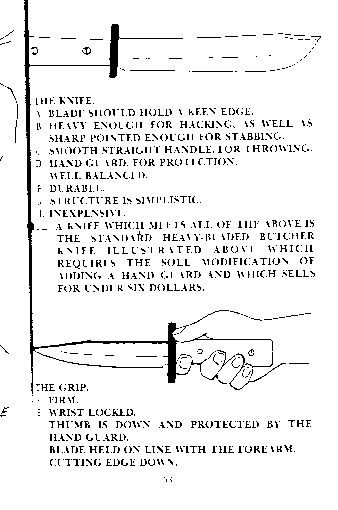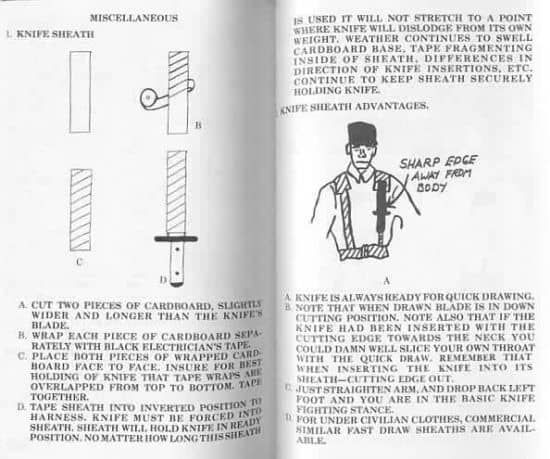In other posts I have discussed whether one needs a fighting knife.
Most of my readers probably own a few multi-purpose knives that will serve if the need for defence arose.
If I needed something more compact, my Moras or Gerber Strongarm would serve well.
The following was taken from “The Soldier’s Handbook” by (Lt. Col) Anthony B. Herbert.

I apologise for the poor quality. The paper is supposed to be copier-proof. This was the best I could do.
A. Blade should hold keen edge.B. Heavy enough for hacking, as well as sharp pointed enough for stabbing.C. Smooth straight handle for throwing.D. Hand guard for protection.E. Well balanced.F. Durable.G. Structure is simplistic.H. InexpensiveA knife which meets all of the above is the standard heavy bladed butcher knife illustrated above which requires the sole modification of adding a hand guard and which sells for under six dollars.
The gentleman had a point [pun intended].
A good butcher knife is a rather useful investment. It has been many decades since they cost six dollars, but they are still very reasonable in price.
As you can see below, mine is made by Victorinox.
I have not felt the need to add a hand guard. The handle design offers some protection to the fingers, and the lack of quillons makes it a little more compact and snag-free.
The only modification is that I used my set of gimlets to add a channel for a retaining cord. Why buy a nice knife and not take precautions against losing it?
Butcher knives like this are designed to be used by professional butchers all day long. Thus the grip is very comfortable and designed to be non‑slip.

My “smaller” butcher knife, with an M3 combat knife for comparison.
This is a 20 centimetre model. I have not been able to find butcher knives shorter than this. Despite its size, the knife itself only masses six ounces (170 g).
The blade is about two millimetres thick, much thinner than your typical hunting, survival or military design.
Because it is so thin, the blade moves fast, is agile and cuts very well, which are not bad traits for a fighting knife. Rather than hacking, as Herbert suggests, the length, thinness and curved edge make this more of a slasher. Being thin but broad, the point is very effective too.
Given it is made by Victorinox, I am confident that the blade is unlikely to bend or break in general use. Being stainless steel, rusting is not a concern either.
The blade has taken a very sharp edge.
It is an intimidating beast that looks bigger than it is. That is quite an endorsement from someone with a house full of kukris.
If the appearance makes an aggressor have second thoughts, that may be a good thing. Sometimes the best weapons are those that do not have to be used.
If you do not like the polished finish, follow the link on darkening steel in the second part of this series.
If you hunt large game, a butcher knife is worth considering adding to your kit. It will dress game much more efficiently than most hunting knives. Is is literally what it was designed for.

I took another leaf from Herbert’s book and made a sheath out of tape as he describes.
For the inner parts, wrap the tape from bottom to top. This makes it easier to insert the blade and helps keep the blade in place once sheathed.
Post‑Halloween trivia: None of the famous movie slashers ever used a butcher knife. Most seem to prefer chef’s knives.
